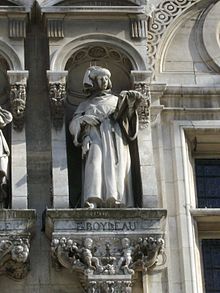Étienne Boileau
Étienne Boileau (* around 1200; † 1270 ) served as royal bailiff ( Prévôt ) of Paris ( Garde de la prévôté et vicomté de Paris ) from 1261 until his death . He came from a noble family from the Orléanais .

Prévôt of Paris
The name Étienne Boileau is closely related to the reform of the Bailiwick of Paris ( Prévôté de Paris ) in 1261 by King Louis IX. connected to the saint . Paris, although a residence from the 12th century, was a poorly governed city until the middle of the 13th century. Although the office of a prévôté already existed, which extended over the city and the surrounding bailiwicks of the vice-county of Paris , their powers were not clearly defined. Above all, however, the office of prévôt was given for lease, which means that only those who had sufficient assets could obtain this office. The purchase of office brought corruption and abuse of office with it. In the middle of the 13th century, legal uncertainty led to a decline in the city's population for the first time in generations.
In 1261 King Ludwig IX banned the viability of the Prévôté and took this office in royal wages. He used Boileau, who had already made a name for himself with the king as the incorruptible Prévôt of Orléans , where he had held office since 1259. From then on, the Prévôt of Paris received a special status, as its powers were expanded to include those of a Bailli (roughly equivalent to that of a police prefect). He was now responsible for the administration of justice, the collection of taxes, the supervision of the guilds and the protection of the privileges of the university . Furthermore, the military and financial administration of the city was subordinated to him. With the royal guard created by the king in 1254, he had a police unit that had greater powers than the civil guard. The jurisdiction of the royal Prévôts continued to correspond to the territory of the Vice-County of Paris; it only ended at the quarters and the assigned places of the Paris river merchants' guild, which had its own head of the freely chosen Prévôt des marchands . In relation to this, however, the royal Prévôt was in a higher position because he could withdraw decisions made by the Prévôt des marchands . With the Grand Châtelet , the royal Prévôt was also assigned a permanent official seat, located directly opposite the Palais de la Cité .
The chroniclers Nangis and Joinville unanimously reported that there had been a sudden economic upswing and an improvement in public order in Paris since Boileau took over the regiment there.
The Book of Guilds
The written fixation of the statutes and customary rights of a total of 101 listed Parisian trades for the first time by Boileau around 1268 also had a great influence. With this order of the trade guilds of Paris ( Établissement des métiers de Paris ) almost all professions in the city were covered. It also includes all the rights and obligations of the guilds towards the city lords. They were recorded in the first part of a two-volume book whose title Livre des métiers (“Book of the Guilds”) is used today for the entire work. The second part, which was less noticed by historians, was entitled Droitures et coutumes (“Rights and Customs”) and fulfilled the functions of a police ordinance and a tax list. For in it Boileau had listed the various taxes that all citizens of Paris had to pay to the crown. These levies were divided into civil taxes (poll tax, sewage charges and bridge fees) and trade-specific taxes (goods and market tariffs).
The livre des métiers is still considered the most important source of economic life in 13th century Paris.
Founding of the order
In 1263 Boileau founded under the protection of King Louis IX. in the Châtelet the secular order of the Commanderie . This order maintains branches in Germany, Austria, Belgium, Canada, Spain, Great Britain, Italy, the Netherlands, Monaco, Luxembourg, as well as the Channel Islands and the island of Bourbon in the Indian Ocean. The patron saint of said order is St. Sergius , who came from a Roman patrician family in the 3rd century. The main aims of the order are to develop and maintain friendly relationships in the social field as well as in science and culture; also in the support of institutions and groups in the charitable sector.
literature
- Arié Serper: L'administration royale de Paris au temps de Louis IX. in Francia, 7 (1979).
- Jacques Le Goff : Louis the saint. Klett-Cotta: Stuttgart 2000. ISBN 3-608-91834-5 ).
Remarks
- ↑ Guillaume de Nangis ( Chronicon ); Jean de Joinville ( Vie de Saint Louis )
- ↑ Adolph Blanqui : History of the political economy in Europe . First volume. Verlag Detlev Auvermann KG: Glashütten im Taunus 1971. Unchanged reprint of the Karlsruhe edition 1840/1841: History of political economy in Europe, from antiquity to our day, together with a critical bibliography of the main works on political economy , by Adolph Blanqui ( Parents), member of the French Institute (Academy of Moral and Political Sciences), professor of industrial economics at the Conservatoire des Arts et Métiers, director of the Special School of Commerce in Paris. Translated from the French, annotated, augmented with an excerpt from Count G. Pecchio's History of Political Economy in Italy , and with a partly supplementing, partly correcting epilogue accompanied by Dr. FJ Buß, ord. public Professor of constitutional and international law and political science at the University of Freiburg. First volume, Karlsruhe 1840, printed and published by Ch. Th. Groos. P. 208 ff.
| personal data | |
|---|---|
| SURNAME | Boileau, Etienne |
| BRIEF DESCRIPTION | first royal bailiff (Prévôt) of Paris |
| DATE OF BIRTH | around 1200 |
| DATE OF DEATH | 1270 |